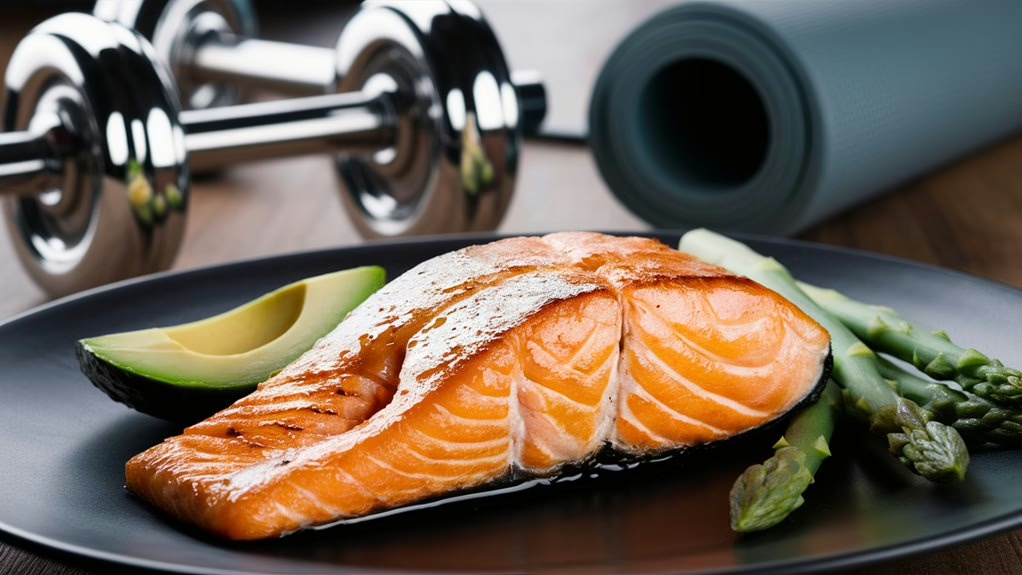Exercising on a ketogenic diet can boost your fitness journey by helping your body become more efficient at burning fat for fuel. You’ll need to give your body time to adapt, typically 2-4 weeks, during which you might experience temporary dips in performance. Focus on starting with low-intensity workouts, gradually increasing intensity as your energy levels stabilize. Staying hydrated and maintaining proper electrolyte balance are crucial, while supplements like MCT oil and BCAAs can support your training goals. Incorporating strength training alongside aerobic exercises will optimize fat burning and muscle preservation. The key to success lies in understanding how to properly fuel your workouts while maintaining ketosis.
Understanding Keto-Adapted Exercise

When you transition to a ketogenic diet, your body undergoes remarkable adaptations that can significantly impact your exercise performance. Your body becomes more efficient at burning fat for energy, which can lead to improved endurance and better overall fitness on the ketogenic diet.
Through this process, your mitochondria, the powerhouses of your cells, become more numerous and effective at using fat as fuel.
As you continue exercise on keto, you’ll notice several positive changes in how your body responds to workouts. Your inflammation levels decrease, helping you recover faster after intense sessions, and your body composition often improves with reduced body fat and maintained muscle mass.
The metabolic shift that occurs during keto and workouts enables your body to access fat stores more readily, providing a steady stream of energy for longer periods.
Your body’s ability to produce glycogen through gluconeogenesis becomes more refined, supporting your endurance activities even without consuming carbs.
This adaptation process involves changes in gene expression and enzyme activity, making you more efficient at using both fatty acids and ketones for fuel during exercise.
Many athletes find that low-carb adaptations enhance their strength training capabilities while maintaining optimal performance levels.
Best Workouts for Keto Success
For those on a ketogenic diet, selecting the right types of exercise can make or break your fitness success. Your best bet is to focus on activities that work well with your body’s fat-burning state, particularly aerobic exercises and strength training.
When you’re following keto for strength training, you’ll want to start with lower-intensity workouts while your body adapts. You can begin with gentle activities like yoga or swimming, then gradually add compound movements such as squats and bench presses to your routine.
These exercises help maintain muscle mass and boost your metabolic rate, which is crucial for success on keto. Regular strength training can help you boost your metabolism even when you’re not actively exercising.
Don’t worry if you notice a temporary dip in performance during high-intensity workouts, as this is normal while your body adjusts. You’ll find that over time, your endurance will improve as your body becomes more efficient at using fat for fuel.
If you’re planning to do intense workouts, you might benefit from adding small amounts of carbs before and after training sessions, known as a targeted ketogenic approach, to optimize your performance and recovery.
Fueling Your Keto Fitness Journey

Successfully fueling your workouts on a ketogenic diet requires understanding how your body uses different energy sources. When you’re on keto, your body primarily burns fat instead of carbohydrates, which means you’ll need to approach exercise nutrition differently than you’d on a standard diet.
During your first few weeks of keto, you’ll go through an adaptation period where your body learns to use ketones for fuel. This transition can take up to four weeks, but once you’re fully adapted, you’ll likely notice improved endurance during longer workouts.
If you’re planning high-intensity exercise, you might want to consider taking 15-30 grams of carbs 30-60 minutes before your workout, as this can help maintain performance without disrupting ketosis.
For pre-workout nutrition, you’ll want to avoid sugary supplements and instead opt for keto-friendly options like MCT oil, which your body can quickly convert to energy.
Just remember not to eat large, fatty meals too close to your workout, as they can be harder to digest. While you might experience some initial performance changes, many athletes find they can maintain and even improve their endurance once they’re fully keto-adapted. The appetite control benefits of a ketogenic diet can help you maintain a caloric deficit while staying energized during workouts.
Avoiding Common Exercise Pitfalls
With proper workout fueling under your belt, it’s important to understand the key pitfalls that can derail your exercise progress on keto.
As your body adapts to using fat for fuel instead of carbs, you’ll need to navigate some common challenges that might affect your workout routine.
- Starting too intensely – Your body needs time to adjust to the keto diet, so begin with low-intensity activities like walking, yoga, or light cycling before attempting high-intensity workouts.
- Neglecting hydration – You’ll need more water than usual on keto, especially when exercising, as your body releases more fluids and electrolytes.
- Skipping electrolyte replacement – Without proper electrolyte balance, you might experience headaches, muscle cramps, and fatigue during workouts.
- Expecting immediate performance – Remember that it can take several weeks for your body to become fully keto-adapted, so be patient with your exercise capacity.
Staying well-hydrated can help you maintain appetite control during your keto journey while supporting optimal exercise performance.
Maximizing Athletic Performance on Keto

Many athletes can maintain and even enhance their performance on a ketogenic diet with the right approach. You’ll need patience during the adaptation period, which typically takes several months, as your body learns to use fat as its primary fuel source instead of carbohydrates.
If you’re an endurance athlete, like a marathon runner or long-distance cyclist, you’ll likely see the most benefits from a keto diet. Your body will become more efficient at burning fat during lengthy, low-intensity activities, which can provide you with steady energy throughout your performance.
However, if you participate in high-intensity sports or activities requiring quick bursts of energy, you’ll need to be more strategic with your approach.
To maximize your athletic performance on keto, you’ll want to work with a nutritionist to create a tailored plan, maintain proper hydration, and pay close attention to your electrolyte balance.
Consider incorporating periodic high-carb meals on intense training days, and make sure you’re getting enough sodium, potassium, and magnesium.
While the diet may take some adjustment, many athletes find success by carefully monitoring their body’s response and making necessary adjustments.
The diet’s ability to help maintain stable blood sugar makes it particularly beneficial for athletes managing type 2 diabetes.
Essential Supplements for Keto Athletes
Supporting your athletic performance on a ketogenic diet often requires targeted supplementation to fill nutritional gaps and optimize training results. When you’re training intensely while maintaining ketosis, certain supplements become especially important to maintain energy, strength, and recovery.
- Start with electrolytes and minerals, including magnesium and potassium, to prevent muscle cramps and maintain proper hydration during workouts.
- Add creatine monohydrate to your routine, as it’ll help maintain explosive power and strength, which can be challenging on a keto diet.
- Consider BCAAs before and during training to preserve muscle mass, but keep portions moderate to avoid disrupting ketosis.
- Include omega-3 supplements and MCT oil to support fat adaptation and reduce exercise-induced inflammation.
You’ll want to pay special attention to vitamin D and B-complex supplements, as they’re crucial for energy production and metabolic health.
If you’re experiencing fatigue during workouts, exogenous ketones can provide an immediate energy boost, though they shouldn’t be your primary fuel source.
Remember to time your supplements strategically around your training sessions, and always start with smaller doses to assess tolerance.
Protein powder supplements can help you meet your daily protein requirements while maintaining ketosis, especially after intense resistance training sessions.
Recovery Strategies While Fat-Adapted

During your fat-adapted journey, recovery strategies play a pivotal role in maintaining athletic performance and preventing burnout.
You’ll need to focus on proper hydration and electrolyte balance, which are crucial when following a ketogenic lifestyle, especially after intense workouts. Make sure you’re replenishing with high-quality electrolyte supplements to maintain optimal fluid balance and support muscle function.
Your recovery approach should include a mix of active and passive techniques. Try incorporating low-intensity activities like walking, yoga, or light jogging to help reduce muscle soreness and clear exercise byproducts from your system.
On training days, you’ll want to prioritize protein and healthy fats to support muscle recovery and reduce inflammation, while being mindful not to overdo carbohydrates which can knock you out of ketosis. If you’re struggling with energy levels, consider using exogenous ketone supplements to support your recovery process.
Remember that rest is just as important as activity when you’re fat-adapted. Give your body adequate time to recover between workouts, and don’t underestimate the power of quality sleep in maintaining your athletic performance and metabolic health.
Consider implementing intermittent fasting periods to enhance your body’s cellular repair processes and improve insulin sensitivity during recovery.
Building Muscle During Ketosis
While recovery strategies set the stage for success, building muscle on a ketogenic diet presents its own unique set of opportunities and challenges.
Proper nutrient timing plays a crucial role in optimizing muscle protein synthesis and recovery.
You’ll be happy to know that muscle growth is entirely possible while maintaining ketosis, especially once your body becomes fat-adapted. The key lies in managing your caloric intake and maintaining consistent strength training routines, even though the diet’s appetite-suppressing effects can make eating enough calories challenging.
To maximize your muscle-building potential on keto, focus on these essential elements:
- Consume 0.8 grams of protein per pound of body weight daily, selecting whole food sources like eggs, fish, and meat.
- Create a caloric surplus of 200-500 calories above maintenance level, tracking your intake carefully.
- Implement regular strength training sessions with moderate to high rep ranges for optimal muscle stimulation.
- Consider using targeted keto approaches, adding small amounts of carbs before intense workouts.
Your body can effectively use ketones for energy during workouts, though you might notice some initial limitations in high-intensity activities.
With proper nutrition and training strategies, you’ll find that building muscle on keto is both achievable and sustainable.
You’re now equipped to combine your keto lifestyle with effective exercise, understanding how to fuel your workouts, build strength, and maintain energy while staying in ketosis. Remember to listen to your body, adjust your routine as needed, and stay patient during the fat-adaptation process. With proper planning, supplementation, and recovery strategies, you’ll optimize your fitness journey while enjoying the many benefits of ketogenic living.



